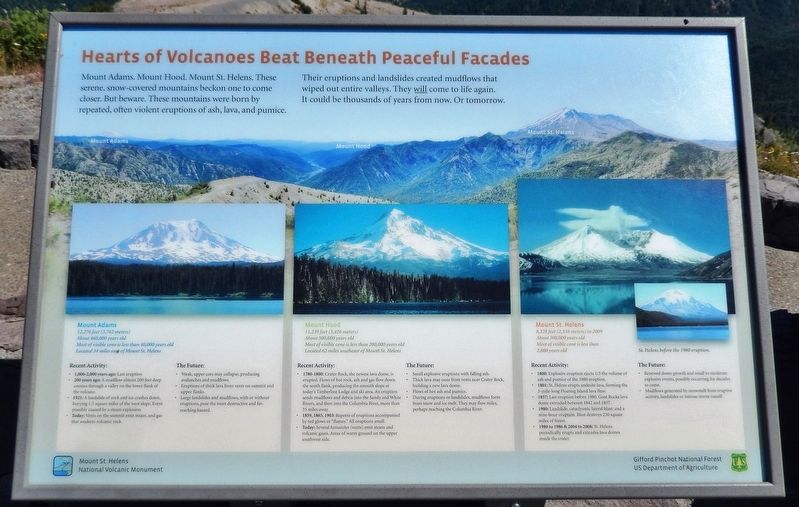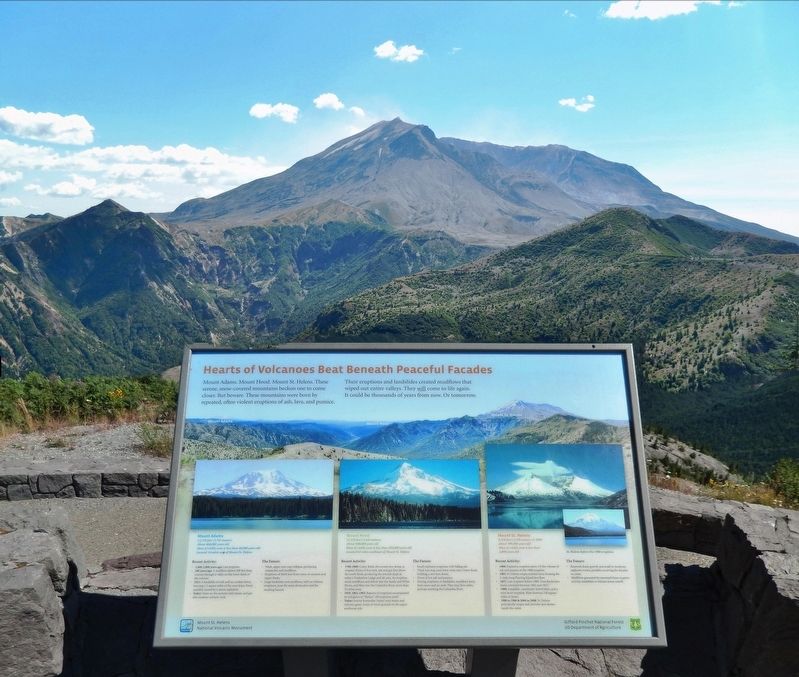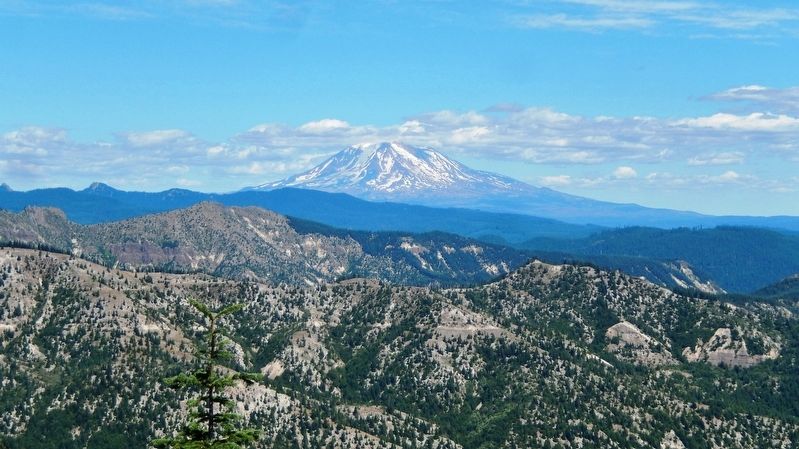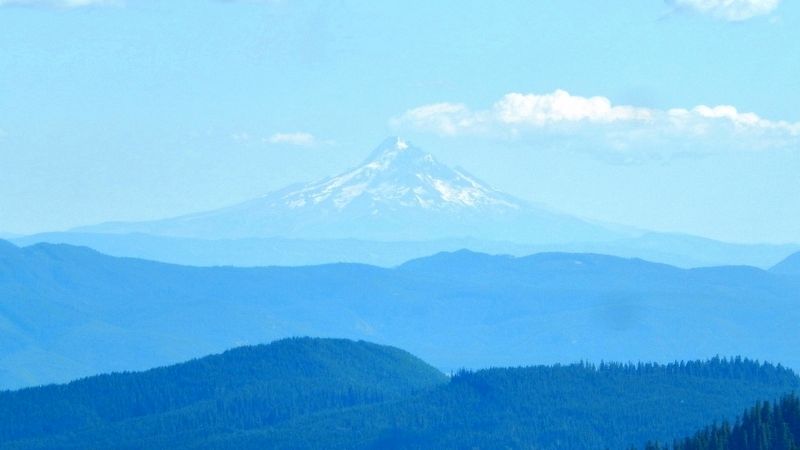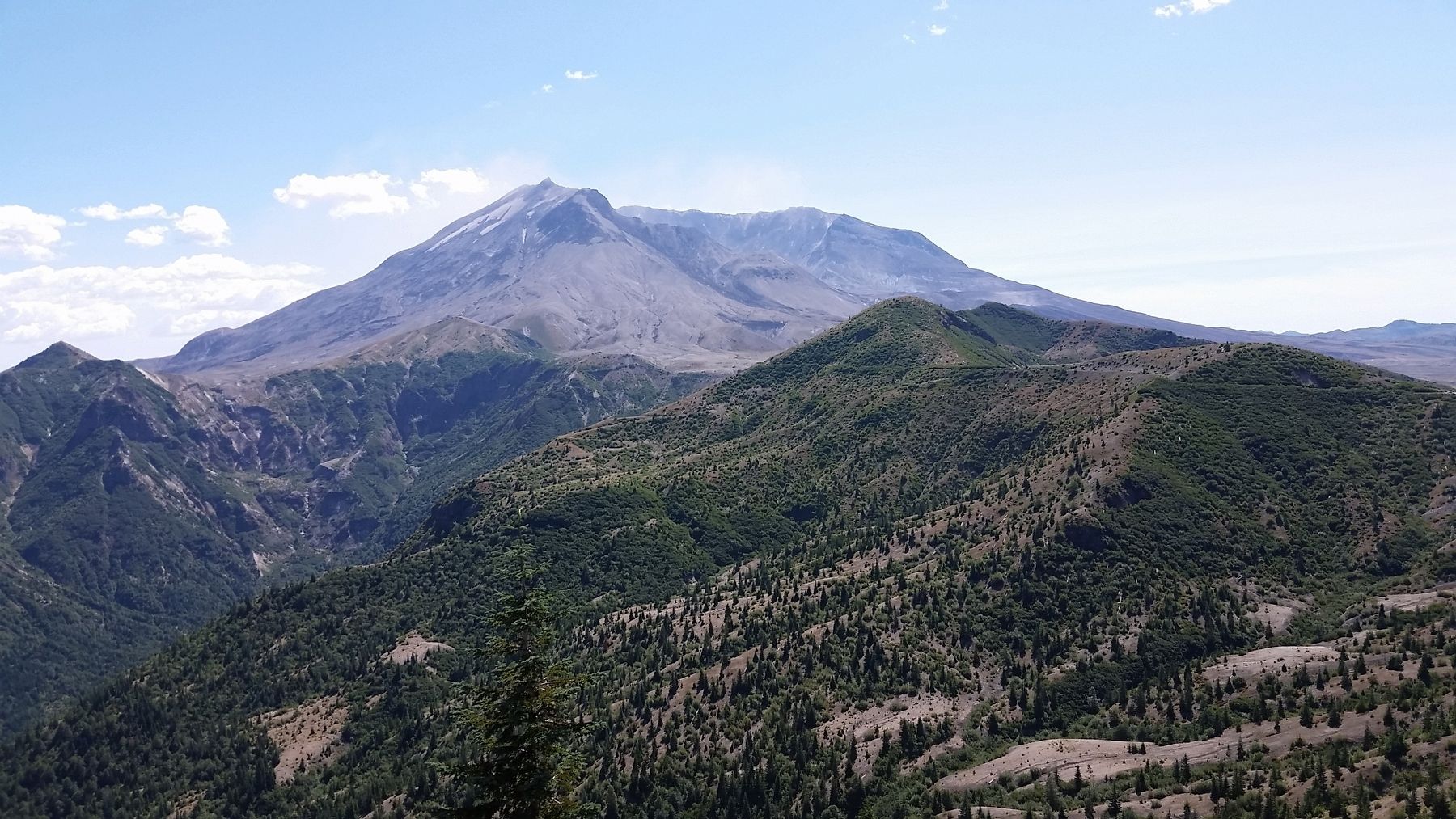Gifford Pinchot National Forest in Skamania County, Washington — The American West (Northwest)
Hearts of Volcanoes Beat Beneath Peaceful Facades
Mount St. Helens National Volcanic Monument
Inscription.
Mount Adams. Mount Hood. Mount St. Helens. These serene, snow-covered mountains beckon one to come closer. But beware. These mountains were born by repeated, often violent eruptions of ash, lava, and pumice.
Their eruptions and landslides created mudflows that wiped out entire valleys. They will come to life again. It could be thousands of years from now. Or tomorrow.
Mount Adams
12,276 feet (3,742 meters)
About 460,000 years old
Most of visible cone is less than 40,000 years old
Located 34 miles east of Mount St. Helens
Recent Activity:
1,000-2,000 years ago: Last eruption
200 years ago: A mudflow almost 200 feet deep courses through a valley on the lower flank of the volcano.
1921: A landslide of rock and ice crashes down, burying 1.5 square miles of the west slope. Event possibly caused by a steam explosion.
Today: Vents on the summit emit steam, and gas that weakens volcanic rock.
The Future:
Weak, upper core may collapse, producing avalanches and mudflows.
Eruptions of thick lava from vents on summit and upper flanks.
Large landslides and mudflows, with or without eruptions, pose the most destructive and far-reaching hazard.
Mount Hood
11,239 feet (3,426 meters)
About 500,000 years old
Most of visible cone is less than 200,000 years old
Located 62 miles southeast of Mount St. Helens
Recent Activity:
1780-1800: Crater Rock, the newest lava dome, is erupted. Flows of hot rock, ash and gas flow down the south flank, producing the smooth slope at today's Timberline Lodge and ski area. An eruption sends mudflows and debris into the Sandy and White Rivers, and then into the Columbia River, more than 35 miles away.
1859, 1865, 1903: Reports of eruptions accompanied by red glows or "flames." All eruptions small.
Today: Several fumaroles (vents) emit steam and volcanic gases. Areas of warm ground on the upper southwest side.
The Future:
Small explosive eruptions with falling ash.
Thick lava may ooze from vents near Crater Rock, building a new lava dome.
Flows of hot ash and pumice.
During eruptions or landslides, mudflows form from snow and ice melt. They may flow miles, perhaps reaching the Columbia River.
Mount St. Helens
8,328 feet (2,538 meters) in 2009
About 300,000 years old
Most of visible cone is less than 2,800 years old
Recent Activity:
1800: Explosive eruption ejects 1/3 the volume of ash and pumice of the 1980 eruption.
1801: St. Helens erupts andesite lava, forming the 3-mile-long Floating Island lava flow.
1857: Last eruption before 1980. Goat Rocks lava dome extruded
between 1842 and 1857.
1980: Landslide, cataclysmic lateral blast, and a nine-hour eruption. Blast destroys 230 square miles of forest.
1980 to 1986 & 2004 to 2008: St. Helens periodically erupts and extrudes lava domes inside the crater.
The Future:
Renewed dome growth and small to moderate explosive events, possibly occurring for decades to come.
Mudflows generated by snowmelt from eruptive activity, landslides or intense storm runoff.
Erected by Gifford Pinchot National Forest, US Department of Agriculture.
Topics. This historical marker is listed in this topic list: Natural Features.
Location. 46° 15.142′ N, 122° 7.101′ W. Marker is in Gifford Pinchot National Forest, Washington, in Skamania County. Marker can be reached from Forest Road NF-99, 15 miles Forest Road NF-25. Marker is located at the Smith Creek Picnic Viewpoint in Mount St. Helens National Volcanic Monument. Touch for map. Marker is in this post office area: Cougar WA 98616, United States of America. Touch for directions.
Other nearby markers. At least 6 other markers are within 6 miles of this marker, measured as the crow flies. Mount St. Helens (a few steps from this marker); The Pumice Plain (approx. 0.9 miles away); Survivors Create Spectacular Change (approx. 1.7 miles away); The Earths Monumental Power (approx. 4.6 miles away); Working with Nature to Rebuild an Ecosystem (approx. 4.6 miles away); More Than He Bargained For (approx. 5.8 miles away).
Credits. This page was last revised on October 31, 2020. It was originally submitted on October 30, 2020, by Cosmos Mariner of Cape Canaveral, Florida. This page has been viewed 127 times since then and 12 times this year. Photos: 1, 2, 3, 4, 5. submitted on October 31, 2020, by Cosmos Mariner of Cape Canaveral, Florida.
